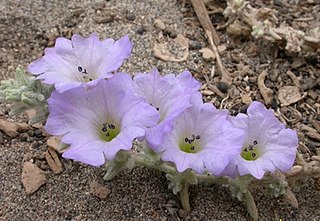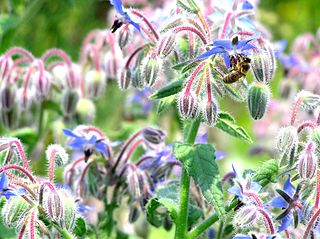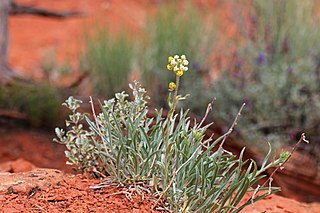
Boraginaceae, the borage or forget-me-notfamily, includes about 2,000 species of shrubs, trees, and herbs in 146 to 154 genera with a worldwide distribution.

Hackelia (stickseeds) is a genus of plants in the borage family, Boraginaceae. It includes 54 species found in North America, western South America, temperate Eurasia, and Australia. 12 species are native to California.

Nolana is a genus of hard annual or perennial plants in the nightshade family. The genus is mostly native to Chile and Peru. Species in this genus, especially N. paradoxa, serve as a model system for studies on flower color.

Bourreria is a genus of flowering plants in the borage family, Boraginaceae. Members of the genus are commonly known as strongbark or strongback. The generic name was chosen by Patrick Browne to honour German pharmacist Johann Ambrosius Beurer. The genus is native to the tropical Americas and to eastern Africa and Madagascar. American species are distributed from Mexico to northern South America, and in the Caribbean and Florida in the United States. The center of diversity is in the Caribbean, Central America, and Mexico. The eastern African species range from Ethiopia to Mozambique and to Madagascar, the Comoro Islands, and Mauritius.

I. M. Johnston, was a United States botanist. He studied at Pomona College in Claremont, California and at Harvard University. His plant collections are housed in the Rancho Santa Ana Botanic Garden, in Claremont, and also in the Gray Herbarium of Harvard University.

Boraginoideae is a subfamily of the plant family Boraginaceae s.s, with about 42 genera. That family is defined in a much broader sense in the Angiosperm Phylogeny Group (APG) system of classification for flowering plants. The APG has not specified any subfamilial structure within Boraginaceae s.l.

Joachim Godske von Moltke was the Prime Minister of Denmark from 1814 to 1818. He was also father of Prime Minister Adam Wilhelm Moltke and the son of Danish diplomat Adam Gottlob Moltke.

Eritrichium is a genus of flowering plants in the family Boraginaceae. It contains 78 species. Notable members include Eritrichium howardii and Eritrichium nanum.
Mimophytum is a genus of flowering plants in the family Boraginaceae. The species are native to northeastern Mexico and adjacent areas of Texas, United States. They are similar to the closely related genus Omphalodes but a distinct group.
Antiphytum, commonly known as saucerflower, is a genus of flowering plants belonging to the family Boraginaceae.
Chionocharis is a genus of flowering plants belonging to the family Boraginaceae.
Johnstonella is a genus of flowering plants belonging to the family Boraginaceae.

Echiochilon is a genus of flowering plants belonging to the family Boraginaceae.
Maharanga is a genus of flowering plants belonging to the family Boraginaceae.
Mairetis is a monotypic genus of flowering plants belonging to the family Boraginaceae. It only contains one known species, Mairetis microsperma(Boiss.) I.M.Johnst.
Lasiocaryum is a genus of flowering plants belonging to the family Boraginaceae.

Moltkiopsis is a monotypic genus of flowering plants belonging to the family Boraginaceae. The only species is Moltkiopsis ciliata.

Nesocaryum is a monotypic genus of flowering plants belonging to the family Boraginaceae. The only species is Nesocaryum stylosum.

Oreocarya is a genus of flowering plants in the family Boraginaceae. There are about 63 species and its native range extends from western and central Canada, through western United States to north Mexico. It is part of subtribe of Amsinckiinae.
Rexford F. Daubenmire was an American botanist and plant ecologist. He made significant contributions to the study of plant ecology throughout the twentieth century, including introducing a vegetation classification scheme, helping define the modern study of ecological succession, and writing the standard reference textbooks for ecologists of the time period. He helped pioneer the sampling techniques still used in vegetation measurement. He served as president of the Ecological Society of America for 1967 and was the 1979 recipient of the Eminent Ecologist Award.












